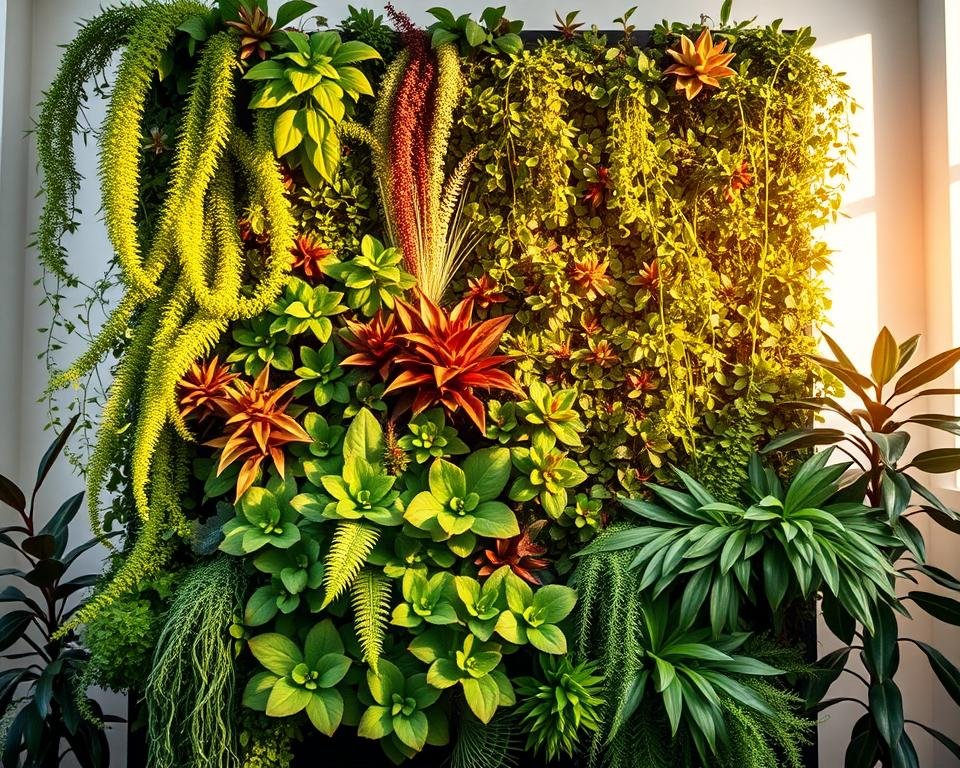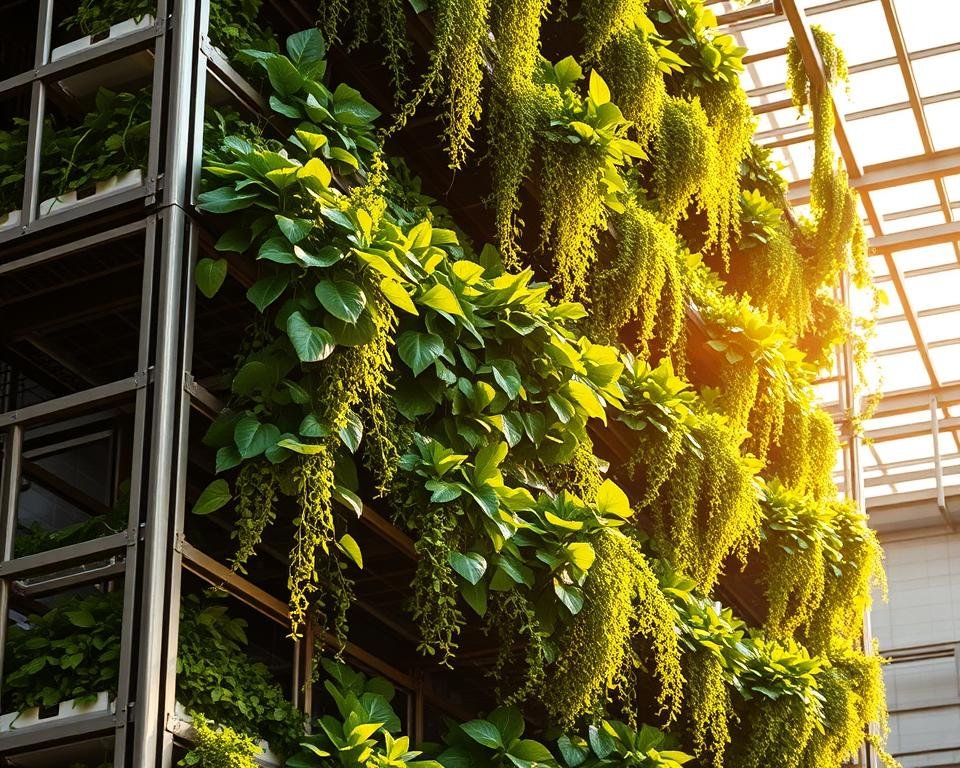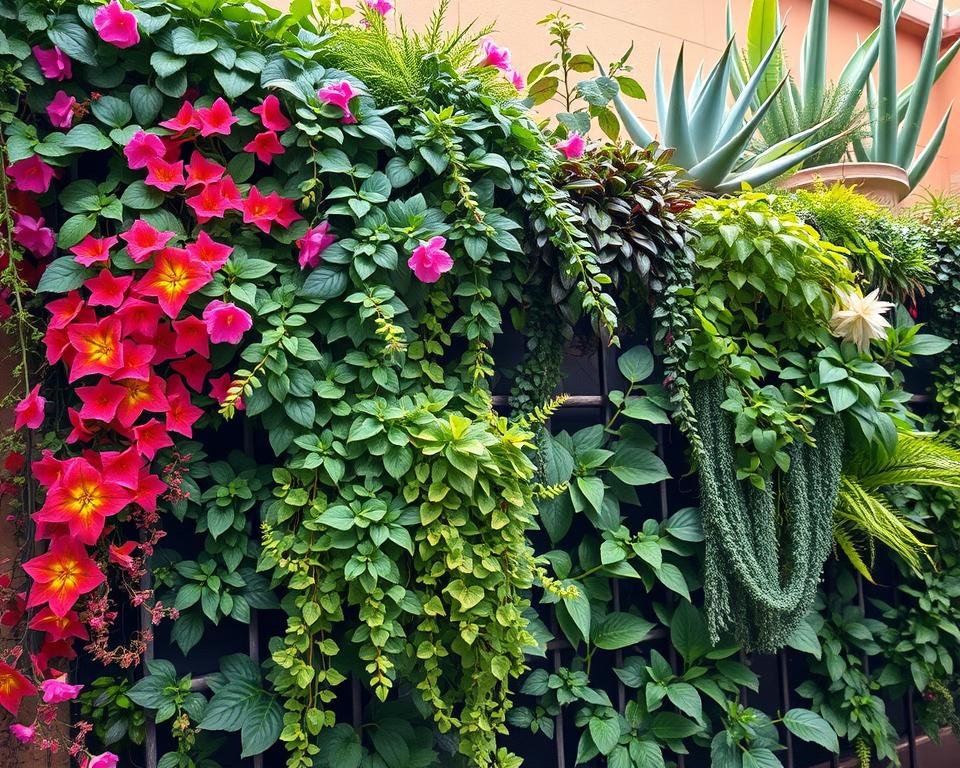Plant Selection for Successful Vertical Gardens
I never imagined my tiny urban apartment could host a thriving mini‑jungle—until vertical gardening proved otherwise. What began as a simple attempt to add green to a concrete backdrop is now a lush, vibrant sanctuary in every corner.
The real key to this success is smart plant selection. Vertical gardening turns balconies, kitchen walls, and even compact backyards into verdant retreats, but only if you choose species that truly excel in upright systems.
For maximum yield and visual impact, focus your plant selection on vining, rambling, and climbing varieties. Cherry tomatoes, cucumbers, and pole beans flourish without hogging ground space, while herbs and trailing flowers fill gaps with colour and fragrance. With the right plant selection, any small area can become a productive, eye‑catching vertical garden.
Key Takeaways
- Vertical-gardening maximizes limited growing spaces
- Select plants that naturally climb or trail
- Improve plant health through better air circulation
- Increase vegetable yield per square foot
- Create aesthetic and functional green spaces
Understanding Vertical Garden Basics
Vertical-gardening is a new way to use small garden spaces. It lets you grow plants up instead of out. This method is great for city folks and garden lovers who want to grow more in less space.
Benefits of Growing Plants Vertically
- Maximizes space utilization by up to 80%
- Increases crop yields by up to 25%
- Reduces physical strain during gardening
- Improves aesthetic appeal of spaces
- Minimizes plant disease risks
Essential Growing Conditions
Vertical-gardening works best when you know a few key things:
| Condition | Vertical Garden Requirements |
|---|---|
| Sunlight Requirements | 6-8 hours of direct light daily |
| Soil Type | Well-draining, nutrient-rich potting mix |
| Water Needs | 30% more frequent watering |
| Climate Adaptability | Varies by plant selection |
Space Requirements and Planning
You can grow a lot in a little space. Even a 2×4 foot area can be a garden. The trick is to plan well and pick the right plants for your spot.
“Vertical gardening transforms limitations into opportunities for green innovation.” – Urban Gardening Experts
Think about sunlight, soil, and water to make your vertical garden a success. It will be beautiful and productive.
Plant Selection for Vertical Gardens
Choosing the right plants is key for a successful vertical garden. The plants you pick will make or break your garden’s look and feel. Plants with special growth habits can turn a plain wall into a colorful, living space.

Look for plants with small growth habits and shallow roots. Some great options include:
- Succulents that need little water
- Herbs like basil and mint
- Trailing vines
- Ferns with soft leaves
Native species are great for vertical gardens. They’re naturally suited to local weather, so they’re easier to care for. They also help local ecosystems and add beauty to your garden.
“Vertical gardening transforms limited spaces into lush, productive green environments” – Urban Gardening Expert
Think about these things when picking plants:
- How much light they need (6-8 hours a day)
- How much water they need
- If they get along with other plants
- If they’ll produce fruit or veggies
Vertical gardening can make your growing space up to 100% bigger. It’s perfect for city folks with little outdoor space. With the right plants, you can make a vibrant, useful vertical garden.
Support Structures and Growing Systems
Vertical gardening needs careful picking of support structures. They should fit your landscaping design and plant hardiness zones. The right support can turn a simple garden into a beautiful vertical landscape.

When designing vertical garden supports, think about several things. You need to ensure plant health and garden looks.
Types of Vertical Garden Structures
Each plant needs its own support system. Here are some common ones:
- Trellises for climbing vegetables
- Pergolas for decorative vine growth
- Wire cages for tomato plants
- Bamboo poles for lightweight climbers
Wall-Mounted Systems and Trellises
Wall-mounted systems are great for small spaces. Planter trellises let gardeners grow vining flowers and veggies in tight spots like patios and balconies.
Selecting the right support structure is crucial for plant health and garden productivity.
Material Considerations for Support Structures
| Material | Durability | Best Used For |
|---|---|---|
| Galvanized Steel | High | Heavy climbing plants |
| Treated Wood | Medium | Decorative garden areas |
| Bamboo | Low | Lightweight climbers |
DIY Support Options
Those on a budget can make their own support structures. Use cheap materials like wooden pallets, old ladders, or metal wire frames. This way, you can create unique vertical garden supports.
Make sure your support structure fits your plants’ needs. Think about their mature size, weight, and growth patterns in your chosen plant hardiness zones.
Best Vegetables for Vertical Growing
Vertical gardening turns small areas into green spaces full of veggies. Choosing the right plants for your vertical garden helps you grow more with less space. Whether you have a small balcony or a tiny patio, vertical gardening is a smart way to grow your own food.

- Tomatoes: Indeterminate varieties like cherry tomatoes grow well in vertical gardens, reaching tall heights with the right support
- Pole Beans: These beans are great for vertical gardens, as they not only grow but also help the soil by fixing nitrogen
- Peas: Perfect for small areas, peas are easy to grow and don’t take up much space
- Cucumbers: They love growing up, needing plenty of sunlight to thrive in vertical gardens
“Vertical gardening isn’t just about saving space—it’s about creating an efficient, productive garden ecosystem.”
To grow veggies vertically, pick the right support and know what each plant needs. Use trellises, cages, and A-frames to help climbing veggies reach the sky.
| Vegetable | Sunlight Needs | Vertical Support |
|---|---|---|
| Tomatoes | Full sun (6-8 hours) | Sturdy cage or trellis |
| Pole Beans | Full sun | Tall trellis or poles |
| Cucumbers | Minimum 6 hours direct sun | Strong vertical frame |
By using these tips, you can make a vertical garden that’s full of life and fresh veggies, even in the smallest of spaces.
Maintenance and Care Requirements
Maintaining a vertical garden needs careful attention. Your garden’s success depends on knowing its plant care requirements. Each vertical garden has specific needs that affect its growth and health.
Watering and Irrigation Systems
Vertical gardens often need more water because of their structure. Here are some irrigation tips:
- Install micro or drip irrigation systems for consistent moisture
- Check soil type to determine water retention capabilities
- Adjust watering frequency based on climate and sunlight requirements
“Consistent moisture is the key to a thriving vertical garden.” – Gardening Expert
Fertilization Schedule
Proper fertilization is crucial for your plants’ nutrition. Focus on balanced nutrition during peak growing seasons:
| Season | Fertilization Approach |
|---|---|
| Spring | High-nitrogen fertilizer to support new growth |
| Summer | Balanced fertilizer with equal NPK ratios |
| Fall/Winter | Reduced fertilization, focus on plant maintenance |
Pruning and Training Techniques
Regular pruning keeps your vertical garden in shape and promotes healthy growth. Use these techniques:
- Trim plants to control size and direction
- Remove dead or diseased foliage promptly
- Train climbing plants using soft ties and supports
Remember that each plant has unique care requirements. Observe your garden closely and adjust maintenance strategies as needed.
Conclusion
Vertical gardening is a new way to use space for growing plants. It works well in small areas. By picking the right plants for your area, you can make a green space that fits your climate.
Success with vertical gardens needs good planning and the right plants. You’ve learned how to keep your garden healthy. This means your garden will be strong and colorful, making your spaces better.
Vertical gardening is great for any size of space. It lets you see your garden in a new way. By using plants native to your area, you can make a garden that’s easy to care for and helps local wildlife.
Begin your vertical gardening journey now. With the right tools and care for your plants, you can turn any space into a beautiful garden. It will show off your creativity and care for nature.







